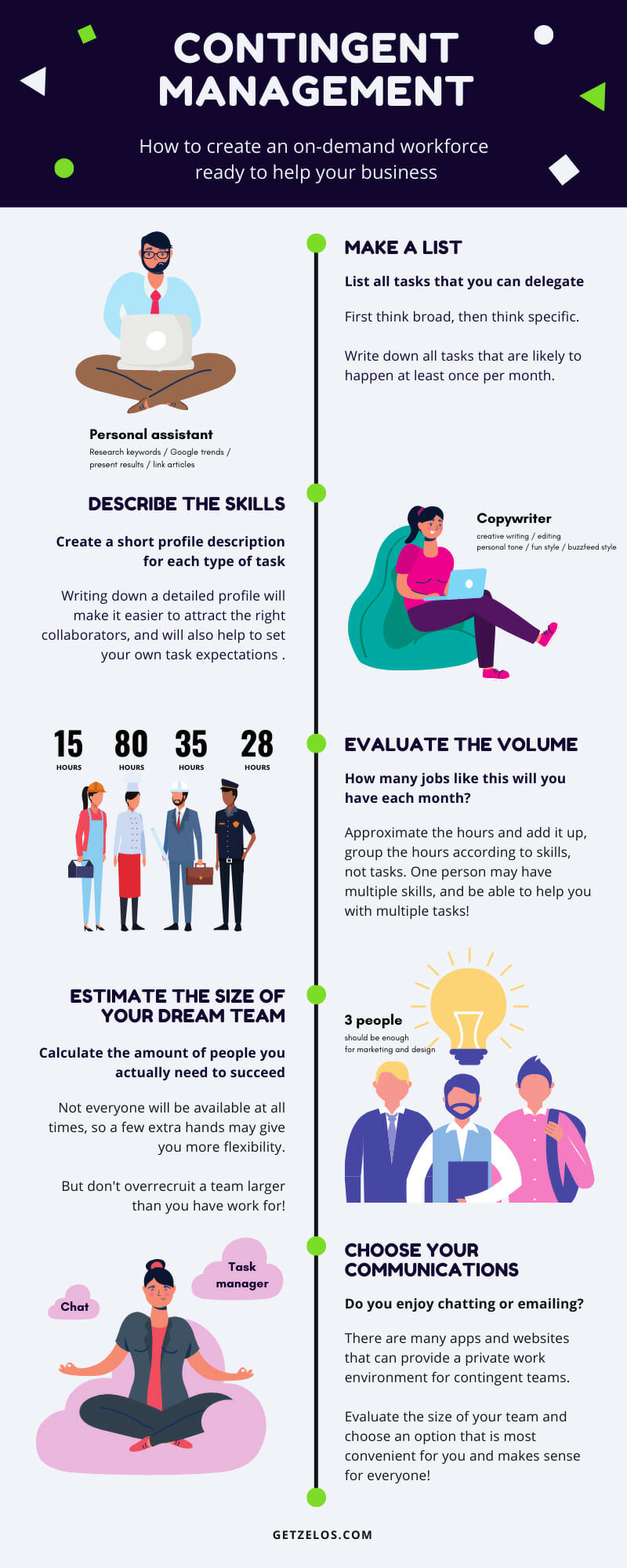What is contingent workforce?
Contingent workers are short-term temporary employees. They are hired to address short-term projects, seasonal demand fluctuations or specialized skills requirements. Sometimes they also cover absences within a company.
Contingent workers usually work for a pre-defined period, and they don’t have a permanent role within the company. This kind of flexibility lets businesses quickly scale their workforce size up and down, without committing to long-term employment contracts.
Contingent workers may also brought on board to tackle particular tasks that do not require a full-time position.
Hiring contingent workers can be more cost-effective for certain projects or short-term needs as they do not typically receive the same benefits and protections as full-time employees.
Contingent workforce management is often handled through agencies or external service providers. This means less administrative overhead for the company, compared to traditional employees.

Contingent workforce management best practices
- Make a list of things that you can delegate in your business.
Check your workflows and daily routines and see which jobs you can easily delegate to your external workforce. While your internal team focuses on key activities, your contingent workforce can take care of routine tasks. This could be simple things as data entry and document prepping.
You can also balance the workload of your internal team by sharing the responsibility with the external workers. Extra hands are alway appreciated during rush times!
- Evaluate the volume of work you want to delegate
Once you have the tasks and profiles determined, calculate the amount of hours or number of activities. This will help you with both budget and management once you start working with a contingent team. Make sure you account for some security overhead in your budgets, and don’t forget that a need to pay taxes as an employer!
- Make a guess on the number of collaborators you want to connect with
Since your additional staff will consider your tasks as an extra gig, include some overhead in your contingent workforce. It’s better to have more contacts than too little!
- Decide on a workflow method
Depending on the number of tasks and people in your contingent team, choose a task and communication strategy. Micro companies can start with just phone calls, email and a chatting app. With larger volumes, it’s probably better to onboard everyone into a productivity app for trackable task management.
- Create a clear workflow
Make sure that your contingent workforce has everything they need. Write clear work instructions and work descriptions, have contract templates ready, specify your payment terms. Make sure your external collaborators can access these documents and can find them easily.
- Start recruiting!
Publish in all your networks that you are looking for contingent workers, using the profiles you wrote before. Ask for referrals! Your contacts may know great people who can help and are available to do small jobs.
- Select the right people
This is the hard part where no advice is perfect. Each organisation will need to find their good way to choose the people who are a good fit. If the volume of applicants is low, you can conduct personal interviews right away. If there’s a lot of candidates, you may ask them to perform some initial checks that suit your field of work.
You can ask them to go through simple skill evaluation, take a personality test, or present them with domain-specific challenges like a mechanical reasoning test for technical positions. - Onboard successful recruits to your workflow
Introduce your new contingent workers individually or in groups. Make sure to mention how your company works, explain how they can pick up and do tasks, and answer any questions. Then, you’re ready to start engaging recruits with tasks!
- Check in with everyone on a regular basis
Make sure to take care of your flexible staff by checking in. Go over new and old information about your workflow and answer questions about it. If you’re making key changes, communicate them instantly. Gather smaller changes for a weekly or monthly summary which will remain available for those who couldn’t attend or need it for future reference.


How we can help
Zelos Team Management is an easy-to use contingent workforce management solution. Focused on self-signup and live communication, it is the preferred choice of modern team managers. Sign up for a free project today, or get in touch with our team for a personal demo session.